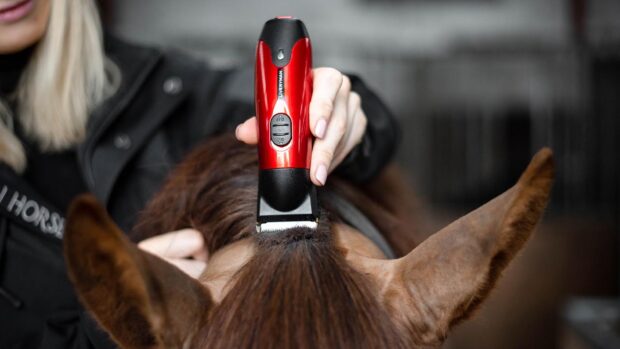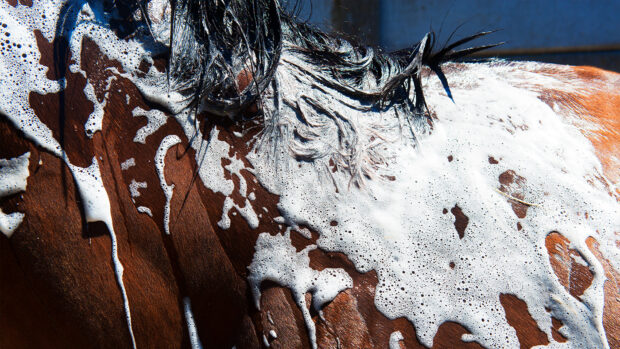Most of us are adept at giving our horses a quick brush to ensure they are clean enough to ride, but knowing how to groom a horse so it gleams is another matter. From bringing your horse in from the field covered in mud, to polishing him up so he’s ready to sparkle at a show, here’s how to do the job properly.
Grooming isn’t just about cleaning the horse, it’s a vital routine to check on his welfare, whether he has any skin irritations, and a chance to check over lumps and bumps, any heat or injuries. If you do this on a regular basis, you will know what’s normal for your horse and whether anything new has cropped up.
How to groom from top to toe
Let’s start with bringing in a muddy horse in from his field. Yours may already be in the stable, and not caked in mud, in which case you can spare a bit of the elbow grease.
Life is easier from a grooming point of view if your horse is rugged – always rug according to the season. Equally an unclipped, fluffy horse is prone to getting wetter and muddier than the clipped horse, so if you have a hairy, rugless horse, your grooming will have to start at square one.
Gather your grooming kit. Ideally you will have one grooming kit per horse, for hygiene reasons. This will prevent skin conditions passing from one horse to another.
Hooves

Start with hosing off muddy hooves – this is a good moment to check the shoes (if worn) are all still on, have not slipped and are not over-worn. Next, pick out the hooves. Feel down the leg, making sure there are no lumps, bumps or heat – this should also encourage the horse to pick up his hoof. It’s easiest to use your arm nearest the leg to pick it up and the other hand to pick out the hooves. Use a hoof pick, avoiding the soft V-shaped frog, to scrape the mud and any stones off the sole, flicking through the grooves from the heels of the hooves away from you.
A small bucket is handy to collect the debris rather than leaving it round the yard. Some hoof picks have a small stiff brush on the top, which you can use to get rid of stubborn mud. You can use a larger stiff brush for this, as some people find the one on the top of the hoof pick too small.
You may want to apply hoof oil on a regular basis to maintain the superficial condition and appearance of the hooves, but consult your farrier if you suspect any serious issues.
Legs
Curry combs do the heavy work in the grooming process, shifting the thick mud. They come in various guises. A plastic currycomb with lots of bristles is useful for getting rid of dried mud, and should be used in the same direction as the hair lies. Although this is a reasonably soft brush, start gently as you assess how your horse tolerates it.
Mud is much easier to brush off when it is dry, so if the horse comes in from the field wet, either let him dry off or wash off the mud with a sponge.
Body

Moving away from the legs, use a rubber curry comb or grooming glove in circular motions from the top of the neck working down towards the quarters. This follows the direction the coat tends to grow and also ensures you have a system for brushing the whole horse. This curry comb should have lots of small pimples and the circular action will lift the dirt, mud, dried sweat, loose hair and grease to the top of the coat. Start gently, making sure that your horse is comfortable, assessing as you go. There will be some areas that your horse is more ticklish or sensitive than others.
Now take the dandy brush. This is made of long plastic bristles and is designed to flick off the dirt that you have just brought to the surface of the coat. It is best used on horses that live out, while you would use a softer body brush on a stabled horse. Body brushes remove grease and oils as well as the dirt, so it’s not advised on horses that are turned out in winter as this grease gives them natural protection from the elements.
Use the dandy brush in conjunction with a metal curry comb, which is used to scrape all the dirt, mud and hair that you are cleaning off the horse’s body from the dandy brush. Take special care with the saddle and girth area to prevent any rubbing underneath the tack.
Wipe the whole body with a stable rubber to lift any remaining dirt or dust.
Head
Back to the front of the horse, use a small face brush or a soft body brush for the head. A horse’s face is sensitive and has many indentations, and the softer brush will allow you to clean all the bony nooks and crannies gently. Undo a latch on the headcollar so you can slide the bits round and make sure you don’t miss any parts which may rub under the tack. Take care to slide the head piece back and brush any mud off from around his ears, because that is where the bridle will lie. Many horses are headshy or wary of having their face and ears brushed, so go carefully and gain his confidence.
Mane and tail
Use a mane comb to brush out any knots and tangles. With the tail, stand to one side of the horse and pull the tail round just in case they don’t enjoy the experience and especially if you don’t know the horse well. Start at the bottom of the tail and work up, getting rid of the knots as you go.
For those horses that have thin or chewed tails, brush them more sparingly. A mane and tail detangler is a great everyday aid to make sure you can brush through the coarser hair easily. Try to get rid of the mud first however, or it ends up being a sticky, muddy mess. And if you’re planning to plait imminently, the detangler can make the hair slippery, so save that for after the plaits are done.
For many owners, your horse has enjoyed a thorough groom, and is now ready to ride – but if you own a grey or coloured horses, you may have more work to do to shift more stubborn stains from the white coat.
Speed grooming
Many of us do not have the time to groom our horse thoroughly every single day. However, there are a few tips and shortcuts to enable you to take care of the most important parts so that you can give your horse a daily once-over and a sufficient clean for a ride squeezed in before work – leaving the longer groom for weekends. This can be completed in under five minutes.
Never skip the overall visual check – for any cuts, bumps and loose shoes. As you pick out the hooves, check for any heat or new lumps on the legs.
Apply mane and tail detangler before you start brushing, and then by the time you’ve finished brushing the body, the detangler will have done its job, making the mane and tail a breeze. You can even leave this working until after your ride – a few shavings in the tail aren’t going to cause him any harm if you can cope with the appearance.
Prioritise brushing the areas that will be covered by tack, using a rubber curry comb to left up dirt or mud patches and brushing out with a dandy or body brush depending on your horse’s coat condition. Wipe over with a stable rubber to remove the last bits of dust and dirt.
And for a bit of a time-saver? Put a rug on your horse. Even a light rain sheet will protect his coat from the worst of the dirt. Make sure you pick a rug appropriate to the temperature and your horse’s condition, and this will save you valuable time brushing out muddy saddle patches.
How to groom for a show

You have groomed your horse as above, but now you want to make him shine. As long as you know you can dry your horse off without him getting chilled – depending on the weather or whether you have heat lamps, wicking cooler rugs and so on – a bath is a great idea. Groom your horse first to get rid of the worst of the dirt, then wash him with shampoo and water.
Make sure your brushes are clean – using dirty brushes on a clean horse will simply replace all the scurf and dirt you’ve worked hard to remove.
How to hot-cloth
- If you do not want to wash your horse, one traditional method favoured by competition riders is hot clothing, which enhances the coat’s appearance and helps lift any remaining dirt or grime. It also helps moisturise the horse’s skin, and as such is great for clipped horses to add shine. It is also an excellent technique for a last-minute finish.
- You’ll need two buckets half-full of warm water, a hot oil, such as Supreme Products Hot Oil, a microfibre cloth or grooming mitt and stable rubber or small towel, plus a sweat scraper.
- Thoroughly groom the horse first.
- Add four squirts of oil to one of the buckets of warm water, drench the microfibre cloth or mitt in the mix and work into the horse’s coat.
- Drench the stable rubber or towel into the other bucket of clean water, wring out excess and rinse the coat.
- Use a sweat scraper to remove excess water from the coat and put on a wicking rug as appropriate.
If you are plaiting, apply mane and tail shine or detangling products afterwards, so that they are not too slippery to handle.
There are also coat shine products available for the finishing touch.
Finally, apply a hoof oil designed for shine, such as Supreme Products Hoof Paint, for your horse to put his best foot forward in the ring.
You may also be interested to read…

How to pull a horse’s mane: your complete guide

How to remove stable stains and keep a grey horse clean

Back to basics: cleaning horses’ hooves — a complete how-to guide

Subscribe to Horse & Hound and get Equilibrium Therapy Massage Mitt, worth £125, as welcome gift
Horse & Hound magazine, out every Thursday, is packed with all the latest news and reports, as well as interviews, specials, nostalgia, vet and training advice. Find how you can enjoy the magazine delivered to your door every week, plus options to upgrade your subscription to access our online service that brings you breaking news and reports as well as other benefits.




